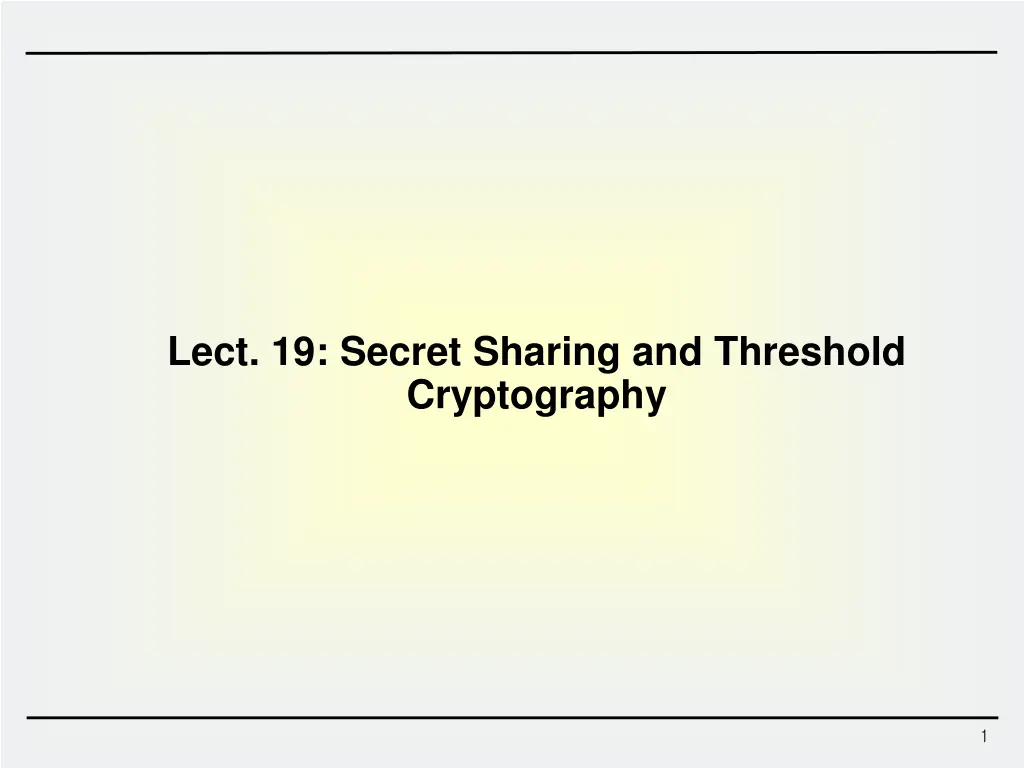
Secret Sharing and Threshold Cryptography Overview
Explore the concepts of secret sharing and threshold cryptography, where secrets are divided among participants for enhanced security and robustness. Learn about the importance of distributing secrets, flaws in trivial sharing methods, and the scenario of threshold secret sharing for heightened security measures. Discover the security issues and benefits offered by threshold secret sharing schemes.
Download Presentation

Please find below an Image/Link to download the presentation.
The content on the website is provided AS IS for your information and personal use only. It may not be sold, licensed, or shared on other websites without obtaining consent from the author. If you encounter any issues during the download, it is possible that the publisher has removed the file from their server.
You are allowed to download the files provided on this website for personal or commercial use, subject to the condition that they are used lawfully. All files are the property of their respective owners.
The content on the website is provided AS IS for your information and personal use only. It may not be sold, licensed, or shared on other websites without obtaining consent from the author.
E N D
Presentation Transcript
Lect. 19: Secret Sharing and Threshold Cryptography 1
Secret Sharing Background Some secrets are too important to be kept by one person. It is easier to trust the many than the few Secrecy (trust) and robustness Example: Purported by Time Magazine in 1992 that the Russian nuclear weapon systems were protected by a two-out-of-three access mechanism President, Defense Minister and Defense Ministry Secret Sharing Distribute a secret amongst a group of participants Each participant is allocated a share of the secret Secret can be reconstructed only when the shares are combined together Individual shares are of no use on their own. 2
Secret Sharing s1 s2 s3 sn-1 sn shares t-1 t Key Holes 1 2 parties 1 2 3 n-1 n
Secret Sharing Flawed secret sharing password pa ss wo rd Flawed Trivial secret sharing A secret s is distributed as s = b1 b2 bn-1 bn 1) Choose random numbers b1, .,bn-1 2) Compute bn = b1 b2 bn-1 s All n shares should be present to recover the secret s (Not robust) 4
Threshold Secret Sharing Scenario For example, imagine that the Board of Directors of Coca-Cola would like to protect Coke's secret formula. The president of the company should be able to access the formula when needed, but in an emergency any 3 of the 12 board members would be able to unlock the secret formula together. This can be accomplished by a secret sharing scheme with t = 3 and n = 15, where 3 shares are given to the president, and 1 is given to each board member. Security Issues Secrecy: resistance against any misbehavior Robustness: reliability against any possible error 5
Threshold Secret Sharing (t, n) Secret Sharing with t<n A secret K is shared among n shares Among n shares, t shares have to cooperate to recover the secret K Robust against partial error Shamir s secret sharing, Blakley's secret sharing, etc. The goal is to divide a secret K into n pieces s1, . . . snin such a way that: Any group of t or more users can jointly obtain the secret; knowledge of any t or more sipieces makes K easily computable. Any group of t-1 or less users cannot jointly obtain any information about the secret. Knowledge of any t-1 or fewer sipieces leaves K completely undetermined. Provides tradeoff between security and reliability according to the choice of t and n. Higher t gives higher security, lower reliability Lower t gives lower security, higher reliability 6
Shamirs Secret Sharing (t, n) Secret Sharing Secret information K n share holders (P1, ,Pn) Using t-1 degree random polynomial with random coefficient (Step 1. Polynomial construction) A dealer selects a secret, K ( < p : prime) as a constant term and t-1 degree random polynomial with arbitrary coefficients as : F(x) = K + a1x + a2x2 + + ak-1xt-1mod p (Step 2. Share distribution) Distributes F(i) (i=1, ,n) securely to share holders Pi. (Step 3. Secret recovery) When t shares =(K1, K2, ,Kt) among n are given, recover K by using the Lagrange Interpolation l = = mod , where p K K , , j j j l j \ j l j 7
Shamirs Secret Sharing Example (3,5) secret sharing K=11, p=17 Construct a degree 2 random polynomial F(x) = K + a1x + a2x2 mod p For a random choice a1=8, a2=7 F(x) = 11 + 8x + 7x2 mod 17 Share distribution K1= F(1) = 7 12 + 8 1+ 11 9 mod 17 K2= F(2) = 7 22 + 8 2+ 11 4 mod 17 K3= F(3) = 7 32 + 8 3+ 11 13 mod 17 K4= F(4) = 7 42 + 8 4+ 11 2 mod 17 K5= F(5) = 7 52 + 8 5+ 11 5 mod 17 K1, K2, K3, K4, K5: shares given to (P1, ,P5) 8
Shamirs Secret Sharing Example (con t) Using the Lagrange interpolation For =(K1, K2,K3) 2 3 1 3 = 1 2 = + + ( ) ( ) ( ) K K K K 1 2 3 2 13 1 9 3 4 ( 3) 13 1mod17 = + 1 2 3 2 1 3 2 3 + 11 (Quiz) Using =(K2, K4,K5), recover secret, K. 9
(B&W) Visual Cryptography What? It is different from the concept of traditional cryptography It depends on perception by the human eyes 10
Color Visual Cryptography Shared Image 1 Original Image Recover Image Shared Image 2 11
